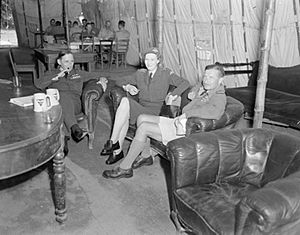Robert Foster (RAF officer) facts for kids
Quick facts for kids
Sir Robert Mordaunt Foster
|
|
|---|---|

Air Marshal Sir Arthur Tedder (left), Lady Tedder, and Air Vice Marshal Foster in the Officers' Mess of No. 8 Wing SAAF at Campoformido, Udine, Italy.
|
|
| Born | 3 September 1898 Richmond, Surrey, England |
| Died | 23 October 1973 (aged 75) Suffolk, England |
| Allegiance | United Kingdom |
| Service/ |
British Army (1914–18) Royal Air Force (1918–54) |
| Years of service | 1914–54 |
| Rank | Air Chief Marshal |
| Commands held | Second Tactical Air Force (1951–53) Home Command (1949–51) No. 3 Group (1946–47) RAF Italy (1946) RAF Austria (1945–46) Desert Air Force (1944–45) RAF Malta (1944) No. 213 Group (1942–43) No. 214 Group (1942) RAF Wyton (1940–41) No. 110 Squadron (1939–40) No. 15 Squadron (1933–35) |
| Battles/wars | First World War Second World War |
| Awards | Knight Commander of the Order of the Bath Commander of the Order of the British Empire Distinguished Flying Cross Mentioned in Despatches (5) Commander of the Legion of Merit (United States) |
| Other work | Deputy Lieutenant of Suffolk |
Air Chief Marshal Sir Robert Mordaunt Foster (3 September 1898 – 23 October 1973) was a brave pilot in the First World War. He later became a very important leader in the Royal Air Force (RAF) during the Second World War and the years that followed. He earned many awards for his service, including the Distinguished Flying Cross.
Contents
Early Life and First World War Adventures
Robert Foster went to Winchester College and then to the Royal Military College, Sandhurst. He became a second lieutenant in the Royal Fusiliers in 1916. Soon after, he joined the Royal Flying Corps, which was the early version of the RAF.
In October 1916, he became a pilot. He flew to France to join No. 54 Squadron. There, he flew the Sopwith Camel, a famous fighter plane. During this time, he shot down at least one enemy plane.
Later in the war, Foster returned to Britain. He helped defend the country while serving with No. 44 Squadron. In April 1918, he went back to France. He became a flight commander, leading a small group of planes, in No. 209 Squadron. He helped take down 16 enemy aircraft during this period.
Earning the Distinguished Flying Cross
On 2 August 1918, Robert Foster was given the Distinguished Flying Cross. This award recognized his bravery and skill. The official statement said he took part in many air battles and led his patrols brilliantly. It also mentioned that he destroyed five enemy planes on his own. One time, he attacked two enemy planes by himself. He forced one down, and the other exploded in the air.
Between the World Wars
After the First World War, on 1 August 1919, Foster officially joined the Royal Air Force. He gave up his role in the Royal Fusiliers on the same day. Later in 1919, he was sent to India. He joined No. 20 Squadron as a pilot.
During his four years in India, he had a dangerous experience. His plane caught fire, and he and his observer had to make an emergency landing. They were captured and held for three weeks before being set free.
In 1924, he was promoted to flight lieutenant. He then attended the RAF Staff College, Andover in 1925. After studying languages, he spent the rest of the 1920s working in intelligence for the RAF in Iraq.
From 1930, Foster flew planes again with No. 70 Squadron. In 1932, he became a squadron leader. The next year, he took command of No. 15 Squadron. In 1935, he returned to Iraq. He worked at the British Forces headquarters and was promoted to wing commander in 1937. Before the Second World War began, he worked on planning for the Air Staff.
Second World War Service
Just a few days after the Second World War started, Foster became a Senior Personnel Officer at No. 2 Group. In late 1939, he took command of No. 110 Squadron. In 1940, he was the Station Commander at RAF Wyton.
In January 1942, Foster took command of No. 214 Group in Iraq. In November of that year, he was promoted to air commodore. He then became the Air Officer Commanding (AOC) of No. 213 Group in Lebanon.
From March 1943, Foster worked on important staff duties for the Mediterranean Air Command. A year later, he became the AOC of RAF Malta and was promoted to air vice marshal. Later in 1944, he led the Air Commission in Italy. This meant he was in charge of the Italian Air Force. Foster didn't stay there long. In December, he became the AOC of the Desert Air Force in North Africa.
After Germany was defeated in August 1945, Foster worked for the Allied Commission for Austria. He was the Chief of the Air Division. A few days later, he became the AOC of RAF Austria.
After the War
In May 1946, Foster returned to Italy as the AOC of RAF Italy. However, just two months later, he was appointed AOC of No. 3 Group of Bomber Command.
From 1947 to 1949, Foster was the Assistant Chief of the Air Staff for Policy. Then, he became the Air Officer Commanding-in-Chief Reserve Command. On 1 July 1950, he was promoted to Air Marshal. His command was renamed, and he became the Air Officer Commander-in-Chief of Home Command.
In October 1951, Foster became the Commander-in-Chief of the RAF's Second Tactical Air Force in Germany. He was promoted to Air Chief Marshal on 28 January 1953. He handed over command in December of that year.
Foster retired from the RAF on 1 February 1954. In April 1968, he became a Deputy Lieutenant of Suffolk. He lived in Great Glemham until he passed away on 23 October 1973.

